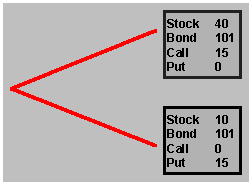Trading Case
OP9
Case
Objective
To
understand the risk neutral valuation principle in a one-period binomial option
pricing model.
Key
Concepts
Binomial option pricing model; option replication. Risk neutral valuation principle, true versus risk neutral probabilities. The case is OP1 except that now the price of the underlying asset is determine by the market.
Case
description
In
OP9 four markets are open: stock,
bond, put and call option markets. The
markets cover one month of calendar time, but you only trade the first day. At the close of the first day, time flashes by and your
position is marked to the realized end of month payoffs. The stock is equally likely to go up to 40 or down to 10 and
this realization in turn determines end of month option values.
The interest rate for borrowing and lending is 1% for the month.
That is, any positive cash balance you have at the end of the first
trading day earns 1% interest and any negative balance pays 1%.
Both options expire at the end of the month, and have a strike price of
25. All
prices, are determined by the traders in the market.
Case
Data
The
following one-period binomial tree shows the cash flows from each security at
the end of the period depending on whether the stock goes up or down which is
equally likely:

Earning Grade Cash
In the trading period securities are exchanged using market cash. Any other amount of market cash will determine your earning grade cash as follows:
